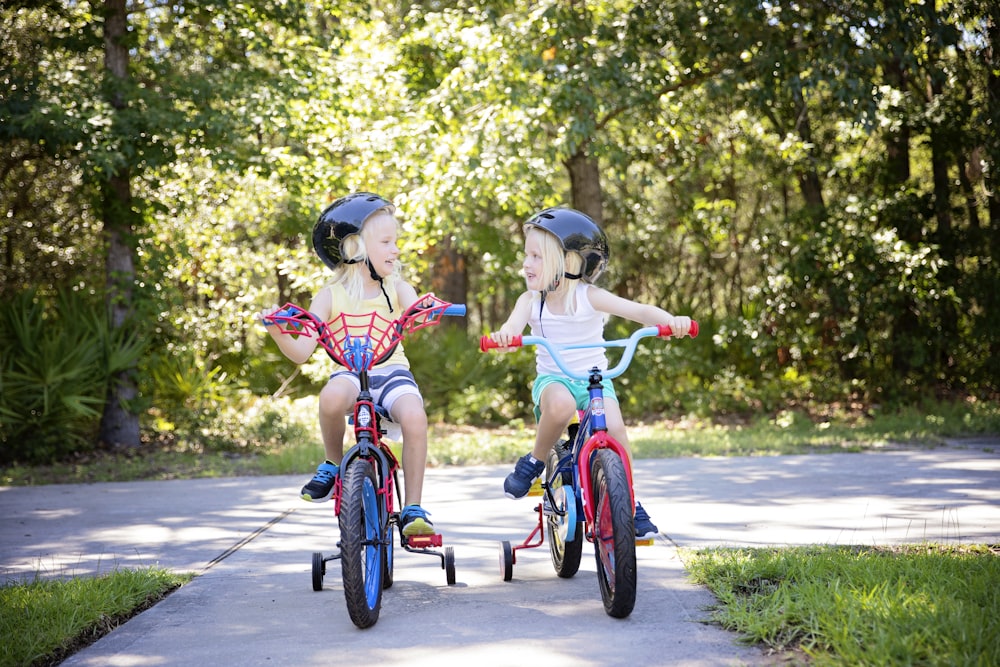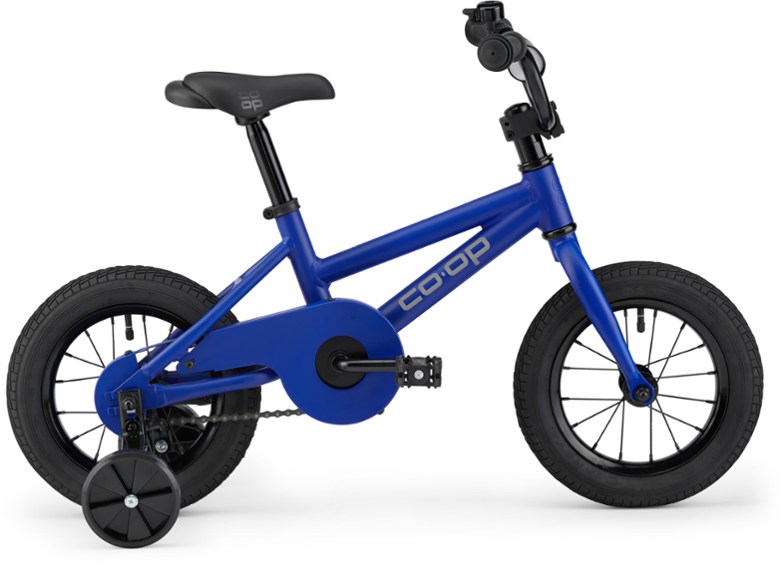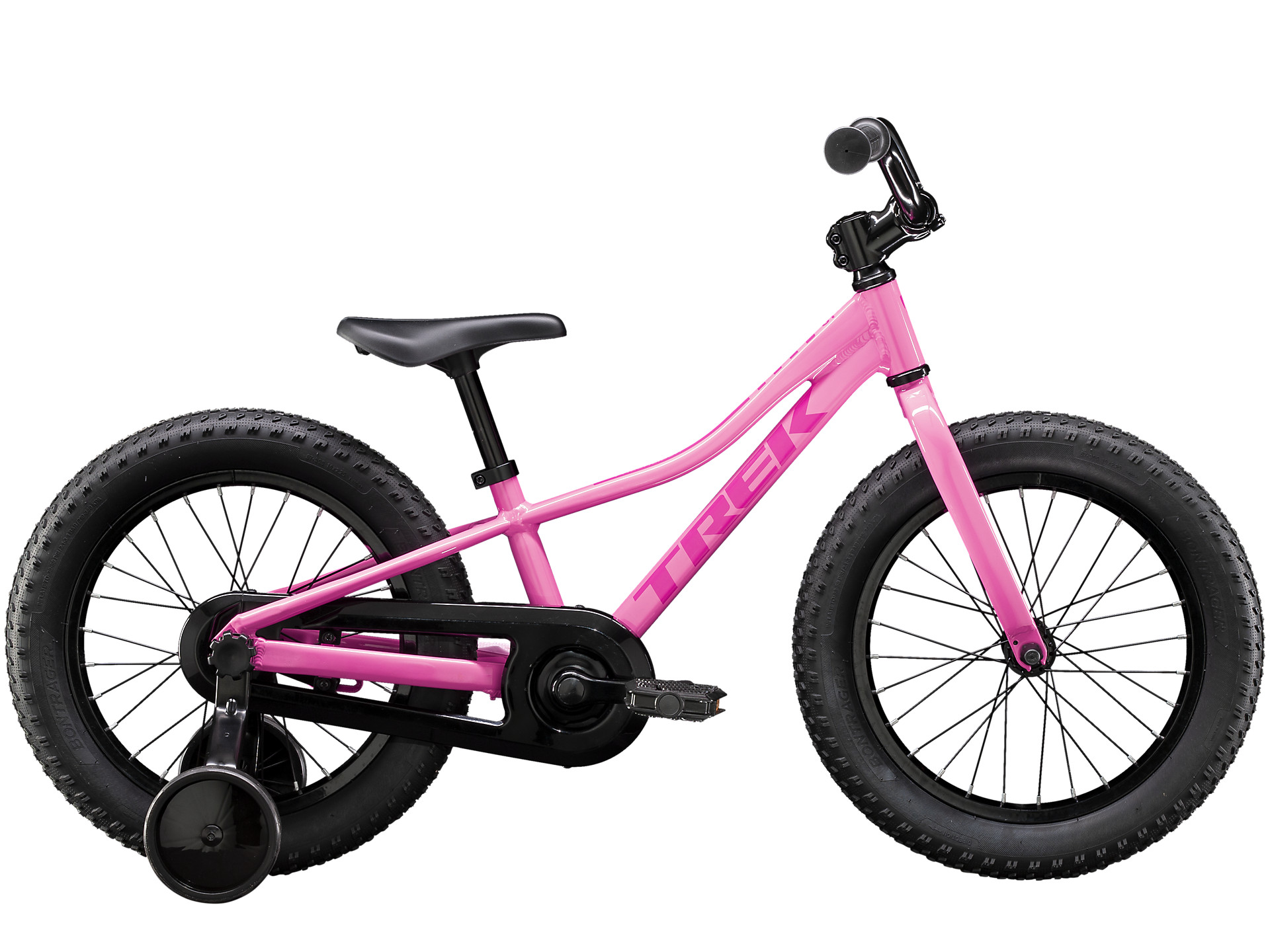The light aluminum frame, step-thru top tube, and coaster brakes make it very easy to operate this bike so kids can focus on getting their balance. Finally, the bike is built with high-quality components typical from the bike giant Trek, so you can rely on this bike for a long time.
Best Bikes for 2 / 3 / 4 / 5 Year Old Kids
Unfortunately, many parents make the mistake of picking a bike that the child will grow into in the future, or one that is cheap and very heavy. This can really diminish the enjoyment of cycling for a child and even be unsafe to ride if the fit is poor.
Finding the perfect bike for your young child will help ensure that they enjoy cycling as much as possible and continue loving it for years to come.
Before you get started on your search for a kid’s bike, measure your child’s height, their inseam length, and have a good idea of their cycling ability so you can choose the best one for riding right now.
In this article, we will cover a list of the best bikes for 2-5-year-olds in different price ranges. Additionally, we will describe how to measure a kid’s bike, how to buy a kid’s bike that fits, as well as some quick tips for parents.
Table of Contents
What size bike does my child need?
The size that your child needs is roughly based on age, but more specifically it depends on their height and inseam length (inseam measuring explained at the end). You want your child to be able to sit on the saddle and still touch their feet or one foot off the ground for balance.
No posts for this criteria.For parents who want to increase the amount of time that their child can use the bike, consider a bike option that allows you to add spacers or make handlebar stem changes. Next, we will look at how to buy a kid’s bike.
Wheel Sizes
Children’s bicycles are generally sold in five different sizes (12″, 14”, 16”, 20”, 24”) which you measure by wheel size instead of the size of the frame.
Although the bike sizes have some overlap, a good rule of thumb is 12” bikes are for ages 2 to 4, 14″ bikes are best for kids ages 3 to 5, and 16″ for ages 5 to 8.
12, 14, or 16 inches are the most common wheel sizes for bikes for the 2-5-year-old kids.
Stand-Over Height
To find the max standover height your child needs, measure your child’s inseam length and subtract one inch. As mentioned, it is important that your child can touch one foot on the ground when they are on the saddle, so this is a good way to ensure that. However, the best way to do it is to test bikes in person at your local bike shop.
Child’s leg inseam > Listed stand-over height
A rough estimate of how to determine a bike size for a kid:
| Bike Wheel | Child Height | Approximate Age | Inside Leg Inseam |
| 12″ | 30″ – 39″ | 2-4 | 12″ – 17″ |
| 14″ | 37″ – 44″ | 3-5 | 16″ – 20″ |
| 16″ | 39″ – 48″ | 5-8 | 18″ – 22″ |
Best Pedal-Bikes for 2-3-Year-Olds
Co-op Cycles – REV 12 Kid’s Bike
Perfect bike for a 3-year-old kid
Wheel Size: 12″ | Stand-Over Height: 14″
MSRP $199
- Weight: 16 lbs
- Weight limit: 80 lbs
- Coaster Brake
- Frame Material: Aluminum
Co-op Cycles REV 12 is one of the best first bikes for a 3-year-old with some great features that make learning to ride safe and enjoyable.
Most notably, this bike comes conveniently fitted with removable training wheels, which is a helpful addition for children still learning. It also comes with a fun customizable sticker pack and a chain guard.
The REV 12 also has a comfortable BMX-style handlebar and a carrying handle integrated so you can help control when they are learning to balance themselves. Unfortunately, this bicycle for 3-year-old kids is a little heavy.
Woom – 2
Best kids’ 14-inch bike

Wheel Size: 14″ | Stand-Over Height: 14.2″ | Min. Seat Height: 16″ | Max. Seat Height: 19″
MSRP $359
- Weight: 12.3 lbs
- Frame: Lightweight aluminum
- Tires: Schwalbe Little Joe 14″ x 1.4″
- V-Brakes with the adapted braking power
- Recommended rider height: 37″-43″
This Woom kid’s bike is a great high-end bike for 3-year-old boys and up to 4 and a half years old.
The Woom 2 makes transitioning to a pedal bike super smooth with a super lightweight and sturdy frame, and a protective design.
Woom includes high-end Schwalbe tires, durable double-wall rims, a protective chain guard, and tough, slip-resistant touchpoints to make this bike very safe and long-lasting.
Finally, an amazing feature of this bike is the helpful color-coded and adjustable brake levers. Kids can learn to brake correctly and safely with this innovative braking system.
Btwin – Unicorn 500 Girl’s Bike
Best 14-inch bike for 3+-year-old girl

Wheel Size: 14″
MSRP $199
- Weight: 19.2 lbs
- Frame: Lifetime warranty
- Brakes especially designed for little hands
Btwin’s Unicorn 500 toddler girl bike would be the perfect gift to your young daughter who is learning to ride independently.
This little bike has training wheels that you can conveniently remove by hand, a low stand-over height for easy mounting and dismounting, adjustable brakes for different hand sizes, and a protective chain guard.
Additionally, the bike comes with fenders and specially designed saddle and grips so your kid is comfortable and safe. Note that this bike does have a heavy steel frame for this age group.
Specialized – Riprock 16 Coaster
Kids bike with training wheels

Wheel Size: 12″
MSRP $300
- Frame: A1 premium aluminum
- Reflectors on pedals
The Riprock 16 Coaster toddler bike with training wheels is designed to be fun and easy to ride with a high-quality build.
Specialized chose a lightweight A1 aluminum frame material for this bike, with a simple coaster brake system to make stopping easy. It also has wide 16″x 2.3″ tires which boost stability and control making learning to balance that little bit easier.
These tires and the durable build make this bike a durable companion. It also has a low standover frame that makes it easier to get on and off as well as non-slip handlebar grips.
XJD – 3 in 1 Kids’ Tricycle
Best bike for 2-year-old

Min. Seat Height: 11.8″ | Max. Seat Height: 14.2″
- Weight: 6 lbs
- Materials: Carbon steel, plastic, metal, rubber
The XJD kid’s 3-wheel bike is perfect for children ages two to three. It’s super lightweight, affordable, and helps your kid get used to pedaling and balancing from an early age.
The bike is sturdy, using a lightweight steel frame and durable plastic wheels. Additionally, it has soft grips and a comfortable saddle, and enclosed wheels to make riding safe and fun for your tots.
Finally, the bike is super easy to assemble on arrival and allows adjustment of the handlebars and seat for your child as they grow.
Best Bikes for 4-5-Year-Olds
Schwinn – Koen
One of the best Amazon kids bikes

Wheel Size: 14″
- Weight: 20 lbs
- Frame: Steel
- Brakes: Caliper, coaster
- Recommended rider height: 36-40″
This Schwinn kid’s bike for boys is a budget-friendly training bicycle option for 3 to 5-year-olds.
To make learning go smoothly, the Koen comes fitted with training wheels and a saddle handle so you can control the bike while your kid learns.
The bike itself has a sturdy steel frame, with forward-positioned pedals, coaster brakes, and simple gearing to make riding easier. Additionally, the bike has a front hand brake which allows them to get used to normal braking once they are ready.
Finally, the Koen is also highly adjustable, allowing modifications to the saddle, seatpost, and handlebars so your child can use the bike as they grow.
woom – 3
Perfect bike for a 4-year-old kid

Wheel Size: 16″ | Stand-Over Height: 16.5″ | Min. Seat Height: 19.1″ | Max. Seat Height: 25.2″
MSRP $389
- Weight: 13.1 lbs
- Frame: Lightweight aluminum
- Steering limiter
- Ergonomically designed seat
- Recommended rider height: 41″-47″
The woom 3 is the company’s 16-inch bike for kids ages 4 to 5. It is very high quality and packed with great features and components for your child to enjoy.
This bike weighs just 13lbs which makes it easy to maneuver and control for young kids. It is also fitted with woom’s color-coded and adjustable handlebar set up to make learning to brake easier and more fun.
Other notable features of this premium kid’s bike are the ergonomic saddle and grips, the protective chain guard, and the high-quality, reflective tires for a smoother, safer ride.
Cannondale – Trail 16 Single-Speed Kids’ Bike
Best Cannondale kids’ bike for 4-year-olds
Wheel Size: 16″ | Stand-Over Height: 17″
MSRP $280
- Weight: 19 lbs
- Frame: SmartForm C3 alloy
- Fork: Steel
- Coaster brake
Cannondale’s 16″ bike with training wheels is great for young kids aged 4 to 5 who are still learning to cycle independently.
This bike is 1-speed and has simple coaster brakes so your kid can build confidence quickly. Cannondale has designed the handlebars, grips, and saddle specifically for little cyclists to be more comfortable and non-slip.
Additionally, the Trail 16 has a riser handlebar which makes balance and control easier. One downside is this bike is quite heavy at 19lbs.
Specialized – Jett 16
16-inch bike for a 5-year-old girl
Wheel Size: 16″
MSRP $450
- Frame: A1 Aluminum Alloy
- V-Brakes
- Tires: 16×2″ Pathfinder Sport
Specialized’s Jett 16 is a premium bicycle that is highly adjustable and built with high-quality components for smooth, durable riding.
This 16-inch girl’s bike has a child-specific saddle and grips, along with grippy pedals to boost safety while riding. Specialized chose an A1 premium aluminum alloy frame to ensure the Jett is lightweight and can be carried by kids as young as 5.
As mentioned, the bike has adjustable handlebars, hand-adjustable brake levers, and a longer seatpost so your kid can keep riding comfortably as they grow. Additionally, the bike has wide and grippy Pathfinder tires to make balancing and handling easier.
Co-op Cycles – REV 20 Kids’ Bike
Best 20-inch bike for a 5-year-old boy
Wheel Size: 20 | Stand-Over Height: 17.4″
MSRP $379
- Weight: 23 lbs
- Weight limit: 80 lbs
- Frame: Aluminum
- 1×6-speed Shimano Tourney
- Brakes: Mechanical disc
Co-op Cycles REV 20 inch bicycle for kids is a highly rated REI product for its durability and build quality, boasting a 4.5/5 rating and 73 reviews.
The REV 20 is one of the best mountain bikes for kids as it comes with powerful mechanical disc brakes, a 6-speed Shimano drivetrain, and a lightweight and durable 6061 aluminum frame that makes this the perfect bike for any confident child cyclists.
This bike can comfortably be taken on light mountain trails as it is fitted with 2.6″ all-terrain tires that absorb shocks and provide extra stability and traction. Finally, the upright MTB geometry with riser handlebars allows for added control. Unfortunately, this bike is quite heavy due to the extra components.
Public Bikes – Sprout C 16
Beautifully designed Dutch-style kids bike
Wheel Size: 16 | Stand-Over Height: 17.4″
MSRP $330
- Weight: 19.25 lbs
- Brakes: KT coaster rear hub
- Training wheels included
The Sprout C 16 is a beautiful, fun kid’s bike with loads of features and a durable build.
This Public bike is designed with the Dutch city cruiser style in mind. It has a convenient step-thru top tube and a relaxed and upright position for breezy riding.
The bike relies on coaster brakes so there are no cables, cutting down on maintenance and tangling. Additionally, the Sprout C bicycle has matching fenders and chainguard to cover the single-speed rust-resistant drivetrain.
For kids learning to ride, this bike can be used perfectly as a balance bike by removing the pedals with optional training wheels included.
Trek – Precaliber 16
Trek 16-inch bike with training wheels for girls
Wheel size: 16″ | Stand-Over Height: 15.3″
MSRP $260
- Weight: 18 lbs
- Frame: Aluminum
- Tires: 16×2.25″ Bontrager XR1
- Recommended rider height: 3’3″ – 3’10”
The Trek kids Precaliber 16 is a great, affordable training bike with a simple design that allows young riders to focus on learning.
It comes fitted with tool-less training wheels that pop off in seconds when your child is ready to ride solo. The Precaliber also has a handle on the saddle so you can guide the bike while they ride.
Rocky Mountain – Growler Jr 20
Best 20-inch kids mountain bike with gears

Wheel Size: 20 | Stand-Over Height: 24″
MSRP $699
- Frame: 6061 alloy
- Fork: 63mm, Suntour XCT
- Brakes: Shimano hydraulic disc
- 1×7-speed Shimano Altus
Kid’s bikes don’t get much better than the Rocky Mountain Growler Jr kids 20-inch mountain bike.
This premium bike is optimized for tough trails, featuring quality components like Shimano hydraulic disc brakes, a 7-speed Shimano Altus drivetrain, front fork suspension, and tubeless-ready rims.
The Growler Jr also uses a lightweight 6061 aluminum frame which has dropper post compatibility for when your kid is ready to step up their mountain biking game.
Additionally, the bike comes with wide 2.6″ Kenda tires which are durable and provide heaps of traction for tricky descents.
Cleary – Hedgehog
Lightweight 16-inch kid’s bike
Wheel Size: 16 | Leg inseam: 17″-21″
MSRP $390
- Weight: 16 lbs
- Frame: Lightweight 1020 alloy steel
- Brakes: Tektro junior v-brakes
- Vegan leather saddle
Cleary’s Hedgehog 16 inch kid’s bicycle comes ready for confident kids who want their first real bicycle experience.
The Hedgehog has a lightweight frame, a simplified single-speed drivetrain, and Tektro v-brakes with child-specific levers which make riding this bike enjoyable and easy.
The bike also has comfortable grips, a vegan leather saddle, and wide, grippy tires which makes cycling on bumpy terrain more smooth.
Best Balance Bikes for 2-5-Year-Olds
Strider – 12 Sport Kids’ Balance Bike
Best toddler bicycle without pedals
Wheel Size: 12″ | Leg inseam: 12″-20″
MSRP $110
- Weight: 7 lbs
- Weight limit: 60 lbs
- Frame: Steel
This Strider balance bike for a 2-year-old is a great, affordable way to get your child started learning how to ride.
The 12 Sport kids’ balance bike is suitable for kids as young as 18-months. It’s lightweight and has a durable steel frame with puncture-proof tires that will easily last until your kid is ready for their own real bike.
Additionally, you can adjust the handlebars and seat tool-free as your kid grows, fitting up to 20″ inseams (roughly 5 years old).
Stacyc – 12eDRIVE Kids’ Bike
Best electric balance bike for toddlers

Wheel Size: 12″ | Stand-Over Height: 13″ | Seat Height: 13″
MSRP $659
- Weight: 17 lbs
- 3 power modes
- Battery runtime: up to 60 minutes
Stacyc’s 12eDRIVE kid’s balance e-bike is a unique option for parents who want to give their kids an exhilarating first biking experience.
Designed for kids with an inseam of 14″ to 20″, this bike has three power modes that allow you to progressively train your child on the balance bike.
Start by learning to push, balance, and use the brakes, and advance with some light power from the motor. The bike itself has an aluminum frame, large pneumatic tires, and a 2Ah battery with 30 to 60 minutes of run time.
woom – 1

Wheel Size: 12″ | Stand-Over Height: N/A | Min. Seat Height: 10″ | Max. Seat Height: 14.4″
MSRP $199
- Weight: 6.6 lbs
- Weight limit: 110 lbs
- Frame: Lightweight aluminum
- Recommended child height: 31″ – 40″
The woom 1 is the company’s 12-inch toddler bike that is used to train your child to balance and get comfortable being on a bicycle.
It is super lightweight at 6.6lbs, comes with an adjustable front brake lever, and has a unique steering limiter that stops overturning and prevents some unwanted spills.
Additionally, the 1 has comfy, non-slip touchpoints, and durable Shwalbe G-One tires with plenty of traction and reflective sidewalls.
Specialized – Hotwalk
Ideal bike for a 1-year-old kid

Wheel Size: 12″ | Leg inseam: 15″-18″
MSRP $200
- Frame: Specialized premium aluminum
- Airless tires
The Specialized Hotwalk is a stylish balance bike for 1-year-old or 2-year-old kids.
The bike is designed to make learning easy with a very low step-thru frame, non-slip touchpoints, and a wide wheelbase that boosts stability.
The bike is suitable for kids with inseams measuring 15″ to 18″, roughly 18 months to 4 years old. Finally, the bike itself has a tough but light A1 aluminum frame, durable alloy wheels, and Rhythm Lite Airless tires that do great off-road.
Bike Buying Tips for Parents
Brake Lever Distance
Adjusting brake lever distance for your child’s hand size is vital to ensure they can ride safely and with confidence.
The best way to do this is to have your child sit on the bike and try to pull the brakes. They should be able to comfortably pull the brakes with their first three fingers wrapped around the lever. Check out this video tutorial on how to adjust brake lever reach.
Can the kid reach the handlebars?
When choosing a bike for your child, ensure they can comfortably reach the handlebars without having to bend forward significantly.
Aggressive riding positions that require the kid to bend at the hip can make learning more difficult and it makes the bike harder to control and handle compared to an upright relaxed position. As the child grows, consider adding handlebar spacers or a longer handlebar stem.
Correct Seat Height
When your child begins their cycling journey, it is important to make sure they can keep their feet on the ground while sitting on the saddle. This boosts confidence and makes the learning process safer.
As your child’s ability progresses, you can raise the seat so that they can just touch the tiptoes while sitting until eventually, they can sit on the saddle with one foot touching the ground only.
Safety Gear
Having the correct safety gear will go a long way in making sure every ride is safe and fun for both you and your child. The following equipment is vital for every ride throughout your child’s learning process and beyond:
- Helmet
- Lights & reflectors
- Pads & gloves (these are most important during the transition to a first unassisted pedal bike)
- Clothes to suit the weather
- Sunblock
FAQs
Where to buy kids’ bikes?
- REI
- woom bikes
- JensonUSA
- Amazon kids bikes | Amazon girls bikes | Amazon boys bikes
- Prevelo
- Spawn bikes
- JoyStar bike
- Raleigh kids’ bikes
- Norco kids’ bikes
How to measure a child for a bike? (Inseam measurement)
- Take off shoes if they’re wearing them and grab a thick-spined book and a measuring tape
- Stand straight in a neutral position with back up against a wall (feet roughly 6 inches apart)
- Press the book up into the crotch flush with the wall, and ask your child to hold it there
- Measure the distance from the floor to the top of the book, this is your kid’s inseam measurement
Where to find an 18-inch girl’s bike?
An 18-inch bicycle is a very uncommon size. As we mentioned at the beginning, the most common sizes are 12, 14, 16, 20, and 24-inch. However, there may be an 18-inch bicycle for girls available on Amazon.





&w=1600&h=900&fmt=auto)






